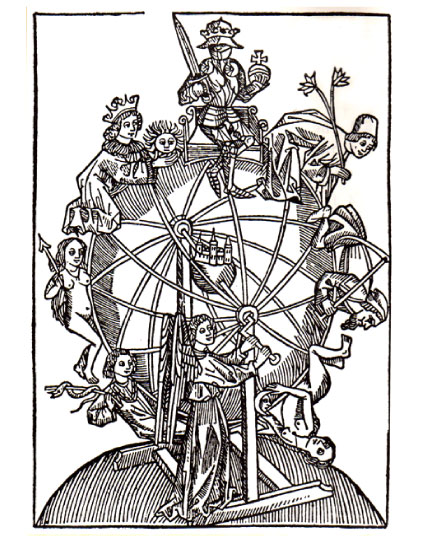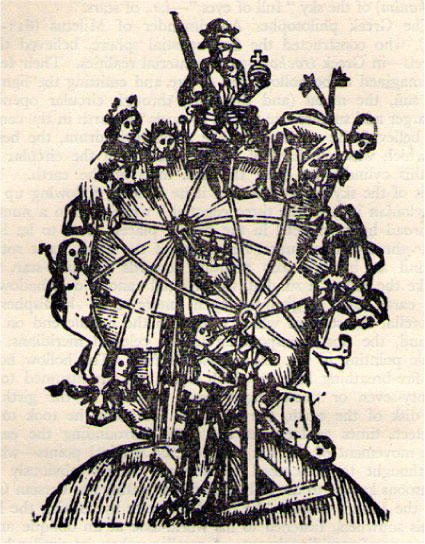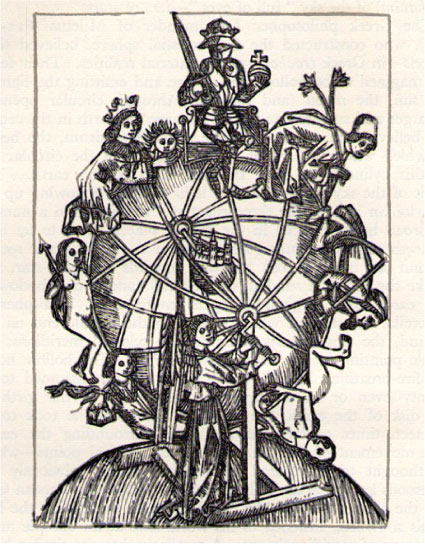
I plan to say much more about this woodcut in the future. For the time being, it's my excuse for talking about computers, the Internet and the spirit of detective work.
I originally found these characters clinging to a wheel in Horoscopes, by Brian Innes. It was published by Macdonald & Co (Publishers) Ltd. in 1977. I found an omnibus edition containing Horoscopes and three other titles at Crown Books in 1989. It sold for $9.99. Crown Books wasn't full-service, but it was always fun to visit. Their attitude about ordering books was that since they already carried thousands of titles, more than anyone could read, you should be able to find something. Cervantes, after all, read scraps of paper from the ground. At least he says he did. I remember the day we walked through an almost empty Crown Books in Santa Barbara. We stopped at Pete's on the other side of the parking lot for coffee. They pulled the plug a few days later. It's a long story — and I'm going to skip almost all of it — but in 1989 when people visited I had to hide Fate and Fortune, the rather optimistic title of the book with Horoscopes in it. The boys and I lived in a house on my uncle's property in the hills east of Irvine. He was a Baptist by temperament, though he attended a Community Church, a good man who attracted the sorts of people who sometimes prophesied hell and damnation if I did not stop reading things besides the Bible. These were good people too, oftentimes unable to read the Bible on their own. It sometimes worked if I handed them a copy and ask them to show me where it says how to fix carburetors. The point being that the Bible is really good at what it does, but it's not all-inclusive. Of course, sometimes they'd say if I prayed more maybe the carburetor wouldn't need fixin. So, it was always easier if Astrology, Palm Reading, Tarot, and I-Ching (the four topics in the book) stayed well out of sight.
The illustration measures just under 6¾ by 9¼ inches and takes up an entire page. It's not exactly the frontispiece, it precedes the first page of text rather than the title page. Neither Innes nor his editor provides much information about it. The caption reads,
Fortune, in the guise of an angel in this fifteenth-century German woodcut, turns her wheel to exert the influence of the individual planets. From Mars in the meridian, the planets symbolised here are (in clockwise order) Jupiter, Saturn, Moon, Mercury, Venus and Sun[.]The idea being that Fortune moves the planets and the planets move us, which is certainly poetic, but even a cursory glance at the print tells us this isn't quite what's going on. I'll save that discussion for another time.
Without realizing it, I acquired a second version of the woodcut as part of Robert Eisler's The Royal Art of Astrology. I tucked it under my arm immediately because it seemed scholarly — unusual for the Astrology section. It was published by Herbert Joseph Limited (London) in 1946. According to the flyleaf, I paid almost $15.00 for it at The Bookman in Orange. Through the years I bought and deposited a mountain of books there. They gave me the teacher's discount, knowing full well I was not a teacher. It gave me a start late one night when I turned to page 32 and recognized this inky version of the wheel.

This time it measures just over 3 by 4¼ inches. In an appendix, Eisler provides the following.
Fig. 3, p. 32. THE WHEEL OF FORTUNE, a lottery wheel circulating the seven planets around the earth in the center by means of a system of hoops combined into a sort of armillary sphere, turned round by the goddess of Fortune.Since before Christmas I've been half-heartedly plugging things into Google hoping for a miracle or at least a fortuitous coincidence. I learned, or at least I convinced myself, that Václav, as in Václav Havel, is the modern equivalent of Wenceslas. I also learned that the things relating to Wenceslas are more numerous and more painfully uninteresting even than the lyrics to his song. I'll never forget Christmas Eve one year when I attended late night service mostly out of politeness and a temporary pastor — no pastor at all in truth — handed everyone a candle about twice the size of a birthday cake candle for what he brightly referred to as a Passing of the Light ceremony. As he lit the first candle the lights were dimmed. The church flickered one by one until it finally glowed. It was his one chance for greatness. He used that chance to say, "Let's sing "Good King Wenceslas." He must have read that "Jingle Bells" and songs about Santa Claus aren't Christian. Those are the ones everyone knows. The organist fumbled with sheet music. People clutched at hymnals. The candles began to drip. He called out, verse after dragging verse, "2nd verse…," "3rd verse…," until the organist, half-way through the 4th verse, stopped and yelled, "Final verse!" With only a few voices left, the church went completely dark.
Frontispiece to Wenceslas of Budovice Judicium Lipsiense for the year of 1490, maily for use in Prag, printed without date or indication of place by Creussner, Nürenberg (Hain-6867). The nearest modern analogy to the world-model of Anaximander of Milet.
I also discovered an interesting Astrological Clock in Prague a short distance from Wenceslas Square, which got my hopes up briefly. In the process I learned that Pivovar Budějovický Budvar is the largest brewery in the town of Ceske Budejovice (Budweis). In addition to producing a Budweiser of its own, it holds most of the European distribution rights for the red, white and blue American Budweiser. Clearly, my candle was guttering.
One depressingly isolated afternoon not long ago, I decided to use what I already had. I had two copies of the woodcut, a smattering of almost meaningless, even erroneous information, and a desire to know more. It occurred to me that although the two copies were significantly different in size and quality, I could always scan them and make them approximately the same size in PhotoShop. Why would I do that? Well… Because I could.

The secret of good detective work — I'm making this up, of course — is to use what you have. Wait — to make good use of what you have. What I had was a large clean copy and a small second or third generation inky one. I was thinking in Xerox terms. Xerox and the 15th century aren't quite compatible. I put the good one on the bottom layer, the bad one on top, and then pinched and pulled until they were each the same size. To do this I made the top layer semi-transparent. What seemed at first like distant relatives now seemed like a case of inadequate reproduction. Almost every detail fell into place. The differences had nothing to do with generations or carving skills.
Doing this ten or fifteen years ago would have been prohibitively difficult. Shooting stats and transparencies and asking for the transparencies to be full and 60% and exactly the same size as the stat… With a cranky lab tech, even at bonus rates, such a project would have been problematic at best. All that and more now fits neatly on the corner of my desk.
What I discovered was the exact opposite of what I suspected. The poor Eisler copy is undoubtedly the older of the two. Engravings and woodcuts work differently. Engravings make tiny trenches, usually in metal plates, for ink to fill and then remain after the rest of the plate is wiped clean. Woodcuts remove everything where nothing should print. In actuality, woodcuts lower the surface of those areas. It's possible to add lines to an engraving after the plate's been used. It's possible to remove lines from a woodcut. But, without special glues and sealers, you can't do the reverse. Both Venus and the Moon have additional contour lines in the Eisler copy. Either the printer carefully removed those lines — only those lines — from his modern day printing plate or else the Innes copy is a later, or younger version. In all probability, at some point in the various 15th century print runs, the printer gouged out those contours because the wood was beginning to weaken and muddle the print. It's also possible, though seemingly improbable, owing to the quality of the final product, that the printer of the Eisler copy added them. I hope you're following this.
For my next act, I will try to explain why any of this makes the slightest bit of difference.
The thing about detective work, as I tried to explain, is that you go with what you've got until it no longer leads anywhere. I was terribly impressed with the conclusions I reached, utterly amazed that I had managed such complicated feats, all without leaving my desk, and I was also, once again, at a completely dead end. What was it that Edison said shortly before he discovered the light bulb? Something about I have discovered a thousand ways it can not be done? Yes, but that's only fun to recount after the great discovery. We scold the town drunk for screwing up repeatedly, but we praise Edison for his perseverance.
Last week I was thinking about miracles. (Remember, I was plugging things into Google hoping for a miracle.) It seemed like nothing amazing or noteworthy had happened for a long time. My life is sometimes brimming with miracles. People who make too much of miracles fail to see that they are prods, things to attract attention. They are not meant to be worshiped or enshrined. Jesus turned water into wine, which is a great story with an interesting astro-symbolic sense to it, but what did he do next? After he got their attention, what did he do next? The answer is, everything came next. He wasn't a one hit wonder. Those who deny miracles tend to be somewhat smug or depressingly disconnected. They just aren't ready for them. But, praying for a miracle is something like asking to be reminded to pray.
Anyway, I was making toast. It was one of those round loaves where only two thirds of the bread fits into the toaster. I was near the end of the second cycle. It occurred to me, as it often does, that expecting answers to be handed to me is a bit like expecting maid service. We hold out hope, but we still end up doing laundry. If the answer was there, and I suddenly had an inkling that it was, then the miracle of finding it would be the act and not the expectation of it. I stood there for the longest time after the toast popped up thinking that the answer wasn't in Google per se, but in England. Both publishers were in London. They had no Google. They had London. I buttered the toast that had lost its warmth and sat down with a purpose at the computer. I typed in british library.
In two cups of tea and four pieces of toast I figured out from a note in a list of incunabula — the word "incunabula" is like incubate, it refers to the earliest printed books — that Hain (of "Hain-6867" above) refers to the late 19th century bibliographer who compiled lists and locations of early books. At the British Library, inside the Incunabula Short Title Catalog, I searched wenceslas 6867 and narrowed the results to Faber de Budweis, Wenceslaus. In the references I found:
Hain, Ludwig. Repertorium Bibliographicum in quo libri omnes ab arte typographica inventa usque ad annum MD. typis expressi ordine alphabetico vel simpliciter enumerantur vel adcuratius recensentur. 2 vols. Stuttgartiae, Lutetiae, 1826-38. 6867* ; Schreiber, Wilhelm Ludwig. Manuel de l'amateur de la gravure sur bois et sur métal au XVe siècle. Tom. 5: Un catalogue des incunables à figures imprimés en Allemagne, en Suisse, en Autriche-Hongrie et Scandinavie. 2 parts. Leipzig, 1910-11. 3944 ; Klebs, Arnold C. Incunabula scientifica et medica: short title list. Bruges, 1938. (Reprinted from Osiris, vol.IV.) 387.11 ; Bayerische Staatsbibliothek Inkunabelkatalog. Bd. I [etc]. Wiesbaden, 1988- [in progress]. F-14 ; Gesamtkatalog der Wiegendrucke. Bd. I [etc.] Stuttgart, etc., 1968- [in progress]. (Vols. 1-7 reproduced with additions and corrections from the original edition (Leipzig, etc., 1925-38)). 9595Did you catch it? "Hain […] 6867*". This is the cryptic reference in Eisler's notes. Wenceslas of Budovice, who has also been Wenceslas Budovicensis is now Wenceslaus Faber de Budweis, author of Prognosticon für Leipzig, 1490.
I can read the Latin that looks like French and the German that sounds like English. I won't pretend to understand all that I am now reporting. The full record for this book contains an ISTC Number — International Standard… somthingorother — if00005440. Googling that number I found my way to the BSB (Bayerische StaatsBibliothek) Münchener DigitalisierungsZentrum Digitale Bibliothek and a downloadable
BSB-Ink F-14GW 9595
Iudicium Lipsense
[Nürnberg] [ca. 1489/90]
4 Inc.s.a.408 c

It sits digitized on a server in Germany. It can also be found in the pages of a book printed five hundred years ago, bound in blue, marked (Hain*6867) on the flyleaf, stamped as belonging to the Bibliotheca Regia Monacensis, about which I know absolutely nothing.
Will miracles never cease?


 Evan Jones
February 07, 2010
Evan Jones
February 07, 2010
